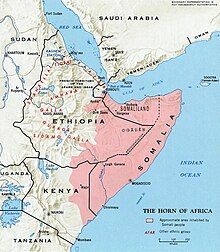User:Wadaad/sandbox
 Traditional area inhabited by the Somali ethnic group | |||||||||||||||||||||
| Total population | |||||||||||||||||||||
|---|---|---|---|---|---|---|---|---|---|---|---|---|---|---|---|---|---|---|---|---|---|
| c. 28–30 million [1][2][3][4][failed verification] | |||||||||||||||||||||
| Regions with significant populations | |||||||||||||||||||||
| Horn of Africa | |||||||||||||||||||||
| 15 million (2017)[5] | |||||||||||||||||||||
| 8.5 million (2017)[6] | |||||||||||||||||||||
| 2.4–3 million (2009-2018)[3][7] | |||||||||||||||||||||
| 534,000 (2017)[8] | |||||||||||||||||||||
360,000-540,000Cite error: A <ref> tag is missing the closing </ref> (see the help page). | |||||||||||||||||||||
| 400,000–1,133,000[9][10] | |||||||||||||||||||||
| 145,812 (+/-6,666)[11] | |||||||||||||||||||||
| 98,000–250,000[12][13] | |||||||||||||||||||||
| 90,900[14] | |||||||||||||||||||||
| 80,000[15] | |||||||||||||||||||||
| 66,369–95,000[16][17] | |||||||||||||||||||||
| 62,550[18] | |||||||||||||||||||||
| 60,000[19] | |||||||||||||||||||||
| 43,196[20] | |||||||||||||||||||||
| 41,515[21] | |||||||||||||||||||||
| 40,000[22] | |||||||||||||||||||||
| 39,737[23] | |||||||||||||||||||||
| 38,675[24] | |||||||||||||||||||||
| 34,000–67,500[25][26] | |||||||||||||||||||||
| 22,709[27] | |||||||||||||||||||||
| 21,210[28] | |||||||||||||||||||||
| 20,944[29] | |||||||||||||||||||||
| 16,169[30] | |||||||||||||||||||||
| 8,228[31] | |||||||||||||||||||||
| 7,025[32] | |||||||||||||||||||||
| 6,161[33] | |||||||||||||||||||||
| 5,518[34] | |||||||||||||||||||||
| |||||||||||||||||||||
| Languages | |||||||||||||||||||||
| Somali | |||||||||||||||||||||
| Religion | |||||||||||||||||||||
| Vast majority: Islam (Sunni, Sufi-oriented) Small minority: Shia, Christianity or Irreligion | |||||||||||||||||||||
| Related ethnic groups | |||||||||||||||||||||
Category:Cushitic-speaking peoples Category:Indigenous peoples of East Africa Category:Ethnic groups in Djibouti Category:Ethnic groups in Ethiopia Category:Ethnic groups in Kenya Category:Ethnic groups in the Arab League Category:Muslim communities in Africa Category:Pastoralists
- ^ UNFPA Somali Population Survey 2014 Archived 7 October 2016 at the Wayback Machine. Somalia.unfpa.org (06 April 2014). Retrieved 06 October 2016.
- ^ "Summary and Statistical Report of the 2007 Population and Housing Census: Population Size by Age and Sex" (PDF). UNFPA. December 2008. p. 16. Archived from the original (PDF) on 5 March 2009. Retrieved 3 September 2018.
- ^ a b "Volume II: Population And Household Distribution By Socio Economic Characteristics". The 2009 Kenya Housing and Population Census. Kenya National Bureau of Statistics. August 2010. p. 398. Retrieved 3 September 2018.
- ^ [1] – Ethnologue.com
- ^ "World Population Prospects - Population Division - United Nations".
- ^ "Recent Survey Releases".
- ^ "Kenya | Joshua Project". joshuaproject.net. Retrieved 17 December 2018.
- ^ [2] – Joshuaproject.net
- ^ [3] – Ethnologue.com
- ^ "Yemen | Joshua Project". joshuaproject.net. Retrieved 17 December 2018.
- ^ Bureau, U.S. Census. "American FactFinder - Results". factfinder.census.gov. Retrieved 26 February 2018.
- ^ Cite error: The named reference
2016 UK estimateswas invoked but never defined (see the help page). - ^ Hemmings, J. (2010). Understanding East London’s Somali Communities. Options UK.
- ^ "Ethnologue United Arab Emirates". Ethnologue. Retrieved 21 February 2018.
- ^ "Ethnologue Oman". Ethnologue. Retrieved 20 August 2018.
- ^ "Statistics Sweden - Foreign-born and born in Sweden".
- ^ Kleist, N. (2018). Somali Diaspora Groups in Sweden. Delmi.
- ^ "Census Profile, 2016 Census - Canada [Country] and Canada [Country]". 8 February 2017.
- ^ PeopleGroups.org. "PeopleGroups.org - Somali of Tanzania". peoplegroups.org. Retrieved 18 December 2018.
- ^ "Immigrants and Norwegian-born to immigrant parents".
- ^ "Iazzolino, G. (2014). A safe haven for Somalis in Uganda?. Rift Valley Institute briefing paper, Nairobi" (PDF).
- ^ Jinnah, Zaheera. "Making Home in a Hostile Land: Understanding Somali Identity, Integration, Livelihood and Risks in Johannesburg" (PDF). J Sociology Soc Anth, 1 (1-2): 91-99 (2010). KRE Publishers. Retrieved 6 March 2014.
- ^ "CBS StatLine - Population; sex, age, origin and generation, 1 January". cbs.nl.
- ^ "Anzahl der Ausländer in Deutschland nach Herkunftsland". Statista.
- ^ "Ethnologue Saudi Arabia". Ethnologue. Retrieved 12 July 2017.
- ^ PeopleGroups.org. "PeopleGroups.org - Somali of Saudi Arabia". peoplegroups.org. Retrieved 18 December 2018.
- ^ "United Nations, Department of Economic and Social Affairs (2015). Trends in International Migrant Stock: Migrants by Destination and Origin".
- ^ "StatBank Denmark". statbank.dk.
- ^ "Population". Statistics Finland. 4 April 2018. Retrieved 6 June 2018.
- ^ "Table 5. Ancestry by State and Territory of Usual Residence, Count of persons - 2016(a)(b)". Australian Bureau of Statistics. 20 July 2017. Retrieved 4 August 2017.
- ^ "Statistiche demografiche ISTAT". istat.it.
- ^ "Federal Statistical Office". Archived from the original on 17 April 2017.
- ^ "Statistik Austria".
- ^ UNHCR (1 August 2018). "Turkey Fact Sheet". unhcr.org.
- ^ "Somalis in Zambia seek better leadership". www.hiiraan.com. Retrieved 18 October 2018.
- ^ "Zambia : Somali Community in Zambia donate 35 trucks for garbage collection". LusakaTimes.com. 10 January 2018. Retrieved 18 October 2018.
- ^ Hertogen, J. "Inwoners van vreemde afkomst in België".
- ^ UNHCR (1 August 2018). "Eritrea Fact Sheet". unhcr.org.
- ^ "Les résultats du recensement de 1999 − Population immigrée et population étrangère en 1999 | Insee". www.insee.fr (in French). Retrieved 18 October 2018.
- ^ Fakhr, Alhan (15 July 2012). "Insecure once again". Daily Jang. Retrieved 10 November 2013.
- ^ "A Comprehensive Survey of Migration Flows and Institutional Capabilities in Libya" (PDF). International Centre for Migration Policy Development. Retrieved 22 March 2018.
- ^ UNHCR (1 August 2015). "Malaysia Fact Sheet". unhcr.org.
- ^ UNHCR (1 February 2016). "Indonesia Fact Sheet". unhcr.org.
- ^ "Ethnic group profiles". stats.govt.nz.
- ^ "Population Usually Resident and Present in the State who Speak a Language other than English or Irish at Home 2011 to 2016 by Birthplace, Language Spoken, Age Group and CensusYear - StatBank - data and statistics". www.cso.ie. Retrieved 12 July 2017.
- ^ Joireman, Sandra F. (1997). Institutional Change in the Horn of Africa: The Allocation of Property Rights and Implications for Development. Universal-Publishers. p. 1. ISBN 978-1581120004.
